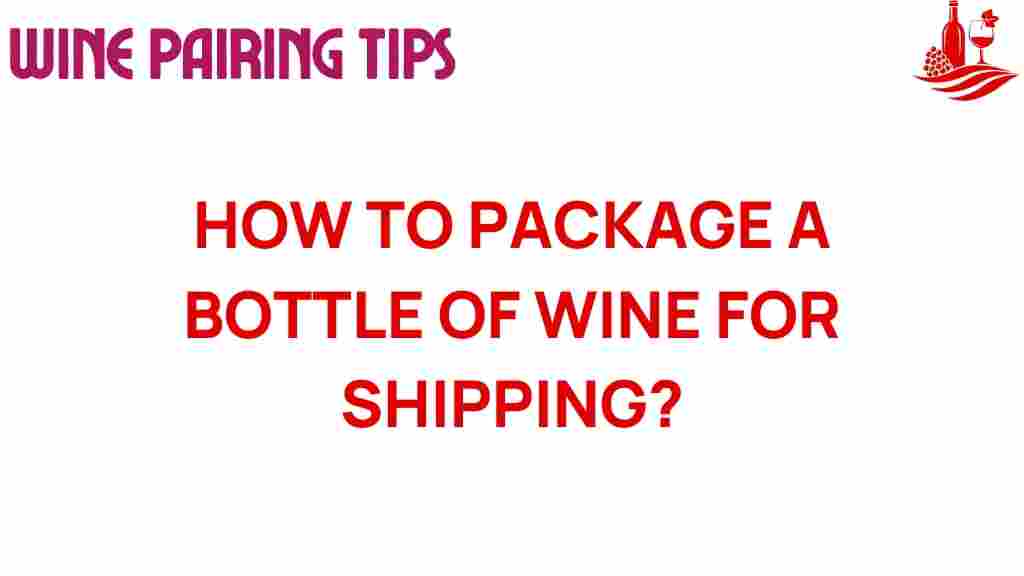Mastering the Art of Wine Shipping: Essential Packaging Tips
Shipping wine can be a complex yet rewarding process. With the increasing popularity of online wine sales, mastering the art of wine shipping is essential for both retailers and individual sellers. This comprehensive guide will provide you with essential packaging tips to ensure the safe delivery of your wine bottles. We will cover various shipping methods, protective materials, shipping regulations, and strategies for enhancing customer satisfaction. By the end of this article, you will be equipped with the knowledge needed to navigate the intricacies of wine transport.
Understanding the Importance of Wine Shipping
Wine shipping is not just about getting a bottle from point A to point B; it’s about ensuring that the wine arrives in pristine condition. The right packaging ensures that your wine bottles remain secure during transit, preventing breakage and spoilage. Here are key reasons why proper wine shipping is crucial:
- Preservation of Quality: Proper packaging protects the wine from temperature fluctuations and physical damage.
- Compliance with Regulations: Many regions have strict regulations regarding wine shipping that must be adhered to.
- Customer Satisfaction: Delivering wine in perfect condition enhances the customer experience, leading to repeat business.
Essential Packaging Tips for Wine Shipping
Now that we understand the importance of wine shipping, let’s delve into effective packaging tips that will ensure the safe delivery of your wine bottles.
1. Choose the Right Shipping Method
Different shipping methods can affect how your wine is transported. Here are some common options:
- Ground Shipping: Ideal for shorter distances, but may expose wine to temperature variations.
- Air Shipping: Faster but can be more expensive; requires careful packaging to prevent movement.
- Freight Shipping: Suitable for large quantities, but requires specialized handling.
Consider the distance, cost, and urgency when selecting a shipping method. For more information on shipping regulations, visit this resource.
2. Use Protective Materials
Protective materials are crucial for ensuring the safety of wine bottles during transit. Here are some recommended materials:
- Bubble Wrap: Provides cushioning and protects against impact.
- Foam Inserts: Custom-fit foam can secure bottles in place, reducing movement.
- Cardboard Dividers: Prevent bottles from clinking against each other.
- Insulated Packaging: Essential for temperature-sensitive wines.
Investing in high-quality protective materials will pay off in the long run by preventing breakage and maintaining wine quality.
3. Properly Seal and Label Your Packages
Sealing and labeling are critical steps in the wine shipping process:
- Sealing: Use strong packing tape to securely seal all seams of the box. Double-taping is recommended for added protection.
- Labeling: Clearly label the package with “Fragile” and “This Side Up” to inform handlers of the contents. Include necessary shipping information and any compliance labels required by law.
4. Consider Temperature Control
Temperature fluctuations can impact the quality of wine. Here are some tips for temperature control during shipping:
- Use Insulated Boxes: Insulated packaging can help maintain a stable temperature.
- Shipping During Cooler Months: If possible, ship wine during cooler months to reduce the risk of heat exposure.
- Temperature Monitoring: Consider using temperature monitoring devices to ensure your wine stays within the ideal range.
Troubleshooting Common Shipping Issues
Even with the best preparation, issues can arise during wine shipping. Here are some common problems and how to troubleshoot them:
1. Breakage
If a wine bottle breaks during shipping, it can lead to significant losses. To prevent this:
- Ensure bottles are tightly secured with protective materials.
- Use a double-box method, placing the wine box inside a larger box filled with cushioning material.
2. Temperature Problems
If wine arrives too warm or too cold, it can spoil. To address this:
- Use insulated shipping materials.
- Monitor shipping times and choose expedited options when necessary.
3. Lost Packages
Lost packages can cause frustration for both sellers and customers. To minimize this risk:
- Use reputable shipping companies that provide tracking services.
- Ensure accurate labeling and address information to avoid misdelivery.
Shipping Regulations to Keep in Mind
Wine shipping is subject to various regulations that vary by region. It’s essential to be aware of the laws governing wine transport in both the shipping and receiving locations:
- Age Verification: Many states require verification of the recipient’s age at the time of delivery.
- State Regulations: Some states have restrictions on shipping wine altogether, while others may require specific licenses.
- Tax and Compliance: Ensure you comply with any taxation or labeling requirements relevant to your wine shipments.
Stay updated on local laws and regulations to ensure compliance and avoid potential fines or delivery issues.
Enhancing Customer Satisfaction through Wine Shipping
Delivering wine in perfect condition is vital for customer satisfaction. Here are some strategies to enhance the customer experience:
- Communication: Keep customers informed about shipping timelines and tracking information.
- Feedback Requests: After delivery, ask for feedback to understand the customer’s experience and identify areas for improvement.
- Quality Packaging: Invest in high-quality packaging materials to ensure the wine arrives safely.
By prioritizing customer satisfaction, you can build a loyal customer base that appreciates your commitment to quality.
Conclusion
Mastering the art of wine shipping involves careful consideration of packaging tips, shipping methods, and regulations. By using protective materials, ensuring proper sealing and labeling, and staying compliant with shipping regulations, you can provide a service that guarantees the safe delivery of wine bottles. Remember, customer satisfaction is paramount, and investing in high-quality shipping practices will pay off in the long run.
For additional resources on wine shipping regulations, check out this informative guide. Happy shipping!
This article is in the category Tips and created by Wine Pairing Tips Team
